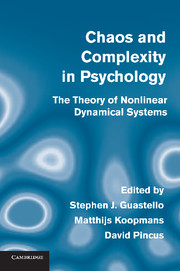Book contents
- Frontmatter
- Contents
- Contributors
- Preface
- 1 Introduction to Nonlinear Dynamics and Complexity
- 2 Collective Intelligence: Observations and Models
- 3 Neurodynamics and Electrocortical Activity
- 4 Psychophysics
- 5 Temporal and Spatial Patterns in Perceptual Behavior: Implications for Dynamical Structure
- 6 Embodied and Embedded: The Dynamics of Extracting Perceptual Visual Invariants
- 7 Origins of Order in Cognitive Activity
- 8 Nonlinear Complex Dynamical Systems in Developmental Psychology
- 9 Developmental Psychopathology: Maladaptive and Adaptive Attractors in Children's Close Relationships
- 10 Psychopathology
- 11 Coherence, Complexity, and Information Flow: Self-Organizing Processes in Psychotherapy
- 12 The Dynamics of Human Experience: Fundamentals of Dynamical Social Psychology
- 13 Group Dynamics: Adaptation, Coordination, and the Emergence of Leaders
- 14 Organizational Psychology
- 15 Complexity, Evolution, and Organizational Behavior
- 16 Agent-Based Modeling Within a Dynamic Network
- 17 Epilogue: Psychology at the Edge of Chaos
- Index
1 - Introduction to Nonlinear Dynamics and Complexity
Published online by Cambridge University Press: 18 December 2013
- Frontmatter
- Contents
- Contributors
- Preface
- 1 Introduction to Nonlinear Dynamics and Complexity
- 2 Collective Intelligence: Observations and Models
- 3 Neurodynamics and Electrocortical Activity
- 4 Psychophysics
- 5 Temporal and Spatial Patterns in Perceptual Behavior: Implications for Dynamical Structure
- 6 Embodied and Embedded: The Dynamics of Extracting Perceptual Visual Invariants
- 7 Origins of Order in Cognitive Activity
- 8 Nonlinear Complex Dynamical Systems in Developmental Psychology
- 9 Developmental Psychopathology: Maladaptive and Adaptive Attractors in Children's Close Relationships
- 10 Psychopathology
- 11 Coherence, Complexity, and Information Flow: Self-Organizing Processes in Psychotherapy
- 12 The Dynamics of Human Experience: Fundamentals of Dynamical Social Psychology
- 13 Group Dynamics: Adaptation, Coordination, and the Emergence of Leaders
- 14 Organizational Psychology
- 15 Complexity, Evolution, and Organizational Behavior
- 16 Agent-Based Modeling Within a Dynamic Network
- 17 Epilogue: Psychology at the Edge of Chaos
- Index
Summary
Elephants and Horses
Things change. Sometimes they change gradually, sometimes dramatically. The prevailing concept of change in psychology consists of only one form of change, linear change, which is simply undifferentiated, and with the assumption that outcomes are proportional to inputs in a straightforward manner. The overreliance among psychologists and others on the general linear model as a statistical tool for depicting change has only served to reinforce this monochrome conceptualization of change. Perhaps the most significant deviations from the concept of linear change are the concepts of equilibrium and randomness. For most intents and purposes, the concept of equilibrium has been used to describe places or times when change stops occurring. Randomness suggests that the changes are unpredictable and not explicable by any known concepts or predictors.
Nonlinear dynamical systems (NDS) theory significantly enriches our capability to conceptualize change, and it provides a rich array of constructs that describe many types of change. The concept of equilibrium is no longer specific enough to describe either the change or the events that surround the point where change stops. The new constructs are the attractors, bifurcations, chaos, fractals, self-organization, and catastrophes. As this chapter explains, each of these constructs contains several more, including those associated with the “complexity” of a system. Importantly, change is not proportional to inputs. Large inputs sometimes produce small results, and a small input at the right time can produce a dramatic result.
Psychology is not the first science to break out of the linear rut.
- Type
- Chapter
- Information
- Chaos and Complexity in PsychologyThe Theory of Nonlinear Dynamical Systems, pp. 1 - 40Publisher: Cambridge University PressPrint publication year: 2008
- 14
- Cited by

